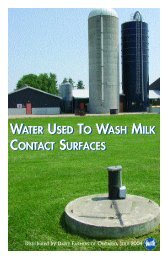Canadian Quality Milk On-Farm Food Safety Program - Centre ...
Canadian Quality Milk On-Farm Food Safety Program - Centre ...
Canadian Quality Milk On-Farm Food Safety Program - Centre ...
Create successful ePaper yourself
Turn your PDF publications into a flip-book with our unique Google optimized e-Paper software.
<strong>Canadian</strong> <strong>Quality</strong> <strong>Milk</strong><br />
APPENDIX I: HAZARDS INDEX<br />
HAZARD SOURCE BEST MANAGEMENT PRACTICES<br />
BIOLOGICAL<br />
Environmental bacteria • Dirty teat and udders<br />
• Dirty hands<br />
• Contaminated milking<br />
equipment<br />
• Infected animal(s)<br />
Bacteria in milk -<br />
microbes on milk<br />
contact surfaces<br />
• Build-up of fat, protein or<br />
minerals on milking<br />
equipment and bulk tank<br />
interior<br />
• Improperly cleaned<br />
equipment (milking units,<br />
pipelines, receiving jar,<br />
tank)<br />
• Malfunctioning<br />
equipment<br />
Establish a SOP for pre-milking.<br />
Establish a SOP for milking.<br />
Ensure teats are cleaned, sanitized and dried.<br />
Establish an SOP for milking animals with<br />
abnormal milk.<br />
Discard abnormal milk.<br />
Use single-service towels to prep teats.<br />
Ensure the environment is clean.<br />
Practice personal hygiene.<br />
Sanitize milking units.<br />
Segregate cattle.<br />
<strong>Milk</strong> infected cattle separately.<br />
Forestrip and milk-out properly.<br />
Examine udder.<br />
Teat-dip after milking.<br />
See Chapter 5.<br />
Regularly inspect all milk contact surfaces.<br />
Test water supply for provincial microbiological<br />
parameters annually.<br />
Establish a Standard Operating Procedure (SOP)<br />
for post milking system cleaning.<br />
Use approved cleaning products according to the<br />
accessible milk house wash charts.<br />
Have written plans outlining how to deal with a<br />
situation when:<br />
• <strong>Milk</strong> contact surfaces are found to be dirty.<br />
• Pre-rinse or wash water is not the correct<br />
temperature.<br />
Check and record pre-rinse water (weekly) or<br />
wash water (monthly).<br />
Have wash system evaluated annually.<br />
Keep milk house and external surfaces of milking<br />
equipment clean.<br />
Check detergent concentration regularly.<br />
Check slugging action during equipment<br />
maintenance check.<br />
Check timing of cleaning system during equipment<br />
maintenance check.<br />
June 2010 Appendix I - 1
















